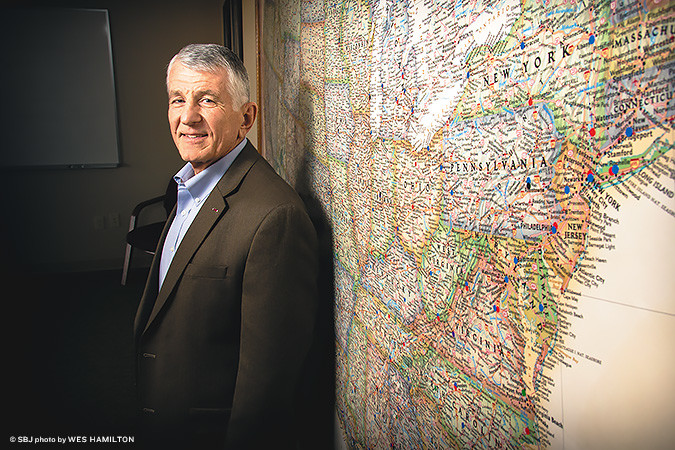YOUR BUSINESS AUTHORITY
Springfield, MO
YOUR BUSINESS AUTHORITY
Springfield, MO

Ozark-based Teen Challenge actually got its start in Manhattan, N.Y. – in the thick of a late 1950s murder trial of seven teenage gang members.
Pennsylvania pastor Dave Wilkerson was reading Life magazine’s two-page spread of the case in his study 265 miles west of New York City, and felt compelled to go help the boys. It was an evangelizing mission. And it failed. Wilkerson was thrown out of the courtroom sternly holding his Bible – as was published in the New York Daily News the next day – and he never spoke to the young men, four of whom were sentenced from 20 years to life.
Little did Wilkerson know, his efforts at the New York courthouse and later in Brooklyn’s most dangerous neighborhoods would be the impetus for some 250 residential treatment centers that today help teens and adults escape life-controlling addictions. The first Teen Challenge home opened in late 1960 in Brooklyn. Just this month, the national office approved a center for adolescent girls in Casper, Wyo., and another is opening in April in Alaska.
Known today as Teen Challenge International, USA, the 501(c)3 organization operates under Assemblies of God U.S. Missions. But the treatment centers sprinkled across the country are set up more like franchisees.
“Each of them uniquely operates on a separate 501(c)3,” says Zollie Smith, Teen Challenge’s board chairman and executive director of AG U.S. Missions.
New Teen Challenge President and CEO the Rev. Joe Batluck calls the “franchisees” independent corporations. Most run multiple centers – there are 83 nonprofit corporations in the system – and Batluck operated eight centers in the Pennsylvania area before taking the headquarters job in Ozark six months ago.
Teen Challenge center operators pay the headquarters $100 per month, covering use of the name and “star man” logo, curriculum, staff training, a student information system and financial guidance. First, centers must meet internal accreditation standards and then pass on-site inspections every three years.
Part of the vetting process, Batluck says center operators are required to have in the bank the first year’s expenses, roughly $250,000, before opening. The center fees represent a third of Teen Challenge’s $1.3 million annual budget. Other operating revenue comes in equal parts from church and business contributions, as well as individual donations.
Each center is primarily donor supported, though Batluck says each student or family in the adolescent program pays roughly $1,500 per month to stay in the residence, at least a six-month term. There is no charge for the adult residential program, which typically lasts 12-18 months.
The stories
Crack cocaine, methamphetamines and alcohol. These are the culprits.
The users’ stories go like this:
• “Huffing was easy and cheap. … Walking around the grocery store, I grabbed an aerosol can and took a hit straight from it and woke up in the hospital.”
• “As a secret drug addict, teaching seemed like a gold mine for prescription drugs. I’d swipe whatever pills the students were taking and eventually I lost my teaching license.”
• “Me, my brother and my sister were all heroin addicts. We couldn’t get it right.”
• “As a paramedic, performing in the moment of crisis was part of the job description, but at night, I couldn’t push the thoughts away. The trauma of everything I’d seen would bubble over, and I found myself turning to prescription pills for relief. Pretty soon, I quit my job but not the drugs.”
• “I dropped out of high school and started dating my drug dealer. Because he controlled my drug supply, my addiction had me bound to him no matter what he did to me. And meth had me numb to the beatings.”
These recorded stories represent some of the 5,000 people Teen Challenge serves each year, and Batluck is unapologetic about the faith-based treatment model. He’s also adamant toward the residential and long-term components, what he calls the simple triad. “First, you make your decision, and then your decision makes you,” Batluck says, leaning on his experience as a 30-year Army chaplain. “You can’t treat a long-term problem in the short term, especially when it’s an addiction.”
In the Ozarks
Two centers operate in the Ozarks: an adult female center in Ozark and a 30-bed boys’ facility on 190 acres outside of Branson.
The rehabilitation work makes its way into the business community. Batluck recalls a bank vice president promoted at age 28 who celebrated by accepting a hit of crack cocaine and got instantly hooked and a 55-year-old with an Ivy League Ph.D. who couldn’t get out of the bottle.
Though the Teen Challenge name stuck, the average age today is 37.
John Allen, the former executive chef of Aviary Cafe and Creperie, moved to Springfield after a stint with Teen Challenge in California. He had become dependent on meth as a teenager and at 18 spent a year behind bars before going through rehab.
“Teen Challenge replaced all the garbage in my life with spiritual truth and the ability to function sober,” Allen said in a December interview with Springfield Business Journal.
He then moved to Springfield to study at Victory Trade School, a faith-based culinary arts program for those sober at least a year.
Batluck says Teen Challenge’s mission is larger than sobriety.
“You could get someone clean and sober by wrapping them up in duct tape and throwing them in a closet for 30 days,” he says. “Our goal is to get their relationship right with God, their family and their community.”
Connected to Watkins Elementary School is a new storm shelter now under construction.
STL construction firm buys KC company
Updated: Systematic Savings Bank to be acquired in $14M deal
Webster University's deficit triples
Missouri House speaker accused of obstruction in ethics probe
‘Dress for your day’: Companies are relaxing dress codes amid evolving ideas about fashion
Developer targets opening by month's end for $10M apartment complex